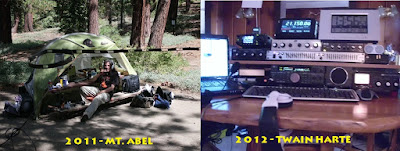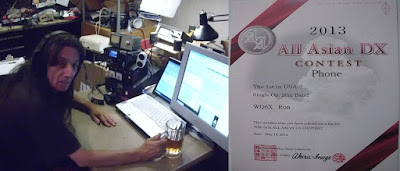In many respects All Asian phone is a more difficult contest than its Cw counterpart. Under marginal space-WX conditions voice communications are more difficult. Additionally, the "language barrier" contributes to comprehension difficulty. In Part 3 of the BLOG Series "The Role of Respect in Radiosport", BEEF #13 is "Stations with choppy English".
This is what I had to say about it:
"This is another variation of the previous BEEF. Your callsign is your trademark.
If we can't understand you, your call will never make it to the log correctly. Now, I AM impressed by
non-English speaking operators who make an attempt at using English during Radiosport contests.
However, saying your callsign correctly and intelligibly is SO important that you should practice
it OVER-and-OVER again BEFORE the contest. Recording your rehearsed-voice in a .WAV
or .MP3 file allows you to play it through your transmit audio over and over again. If necessary,
have someone ELSE (whose voice is similar to yours) say your callsign and YOU record him/her."
Depending on the calendar year, the All Asian phone contest often shares the same weekend
as the KSQP and TNQP QSO parties. At least we contest OPs can have another GiG to engage
in while waiting for propagation to Asia. In years like 2019, All Asian often shares the spotlight with Nebraska's NEQP event.
Being a competitive person, I am always looking for legitimate ways to earn a winner's certificate.
In 2013 I made an ad-Hoc All Asian run from N6GEO's QTH in Brentwood. Because many of the QSOs were made on 20-meters, I submitted the log as a SOSB-20 (single-OP 20 meters) resulting
in a 1st-place win for Zone-3. I wrote this operation up in an early WQ6X contest BLOG entry ([CLICK HERE] to read about that).
This is again another reason to ALWAYS submit a log no matter how FEW QSOs are in it.
If no one submits a log with a higher score - or if their log is DQ'd or the score is drastically
reduced by the LCR (LoG Czeching Robot) then by default we win for that category.
I learned that in reverse in the 1973 Cw-SS Had I submitted my log, an EB-Section win would've been mine, as the WA6 station ahead of me was eventually DQ'd; the actual 3rd-place station
walked away with the certificate and probably thought his win was a FLUKE. Actually his win
occurred by "Cheating, but within the rules" (from a BLOG I wrote on the subject in 2017).
In 2015 I made the drive to Fallbrook a day early
in order that I have the opportunity to load up on
sleep Thursday evening.
Due to a shortage of operators (N6KI, WQ6X & KK6NON running full-time and 3 other OPs coming
in for a couple hours apiece) I knew that sleep would be in short supply.
In the 2 weeks preceding the Asian contest, there were a number of solar storms, even a couple of radio blackouts. For KK6NON, this made for great contest training under adverse space-WX conditions.
When it was all over we took 1st place for North America and 2nd place worldwide - who woulda thunk?!....
For the 2016 event, tired of driving, I rode the Amtrak San Joaquin and Surfliner trains to Oceanside and hopped a ride to Fallbrook to join up with the crew which included a surprise visit from Fabio (IZ4AFW) and a newcomer to contest operating - AA6TU. Tu joined the ham ranks less than 60 days ago, passing all 3 exams to upgrade his call from KM6ECB to a more respectable AA6TU
joining us in the Extra Class Club.
Having an excellent crew sporting a wide-variety of operating skills,
it's no wonder that we were the 1st-Place Multi-Single team in North America.
For 2017 a number of events had transpired earlier in the year, beginning with my Honda Accord being stolen (twice). Unless I rented a car or made the 12 hour Amtrak trip to Oceanside, the likelihood of a physical appearance in Fallbrook was not likely.
 |
| Comet C H - 2 5 0 & WQ6X Lazy U-Vee |
Friday afternoon with its last minute
"Bummer Dewd!" notification.
Having just put up a Cobra Inverted Vee
(a WQ6X Lazy U-Vee) at W7AYT's QTH to complement the CH-250 vertical, I used this weekend to test-drive the antenna installation.
This picture (from that BLOG entry) portrays the tenuous setup; later I added a 2nd Cobra dipole creating the "Infamous" WQ6X Lazy 8JK Sloper , with its accompanying JA-Sloper (that rarely hears any JA's).
Contest-wise, only 1 JA QSO ended up in the All Asian log. Instead, I ran the COQP, TNQP and the CWOPS Cw open contest.
As you can see from the Blog, I used that contest weekend to test drive an early audio filter combination and a custom antenna switch to phase the antennas (without an external tuner to the
FT-1000mp). Today, I no longer phase the antennas (altho I still can); using an MFJ-949E tuner allows me to select one of 3 antennas.
For 2018 I did a split contest operation from W7AYT. Interspersed with running NX6T remotely,
I looked for Alabama stations in the ALQP and experimented with different audio and antenna configurations.
 |
| N 6 K I + N N 6 X + N 6 E E G |
At NX6T we had plenty of operators but unfortunately condx were so POOR that they sat
around much of the time listening to static and playing with their figit spinners. However when the "dust settled", our modest operation ended up in 4th place (worldwide), 2nd-place for North America and #1 for the W6 area; proof once again to never give up. Or as I explained it in a recent BLOG,
it ain't over until it's over; and then some.
While I enjoy the All Asian contest, because of its fickle nature, a lesson to be learned is to have other (backup) contest plans that weekend if you desire the most efficient utilization of your operating time.
So, what can we say about All Asian for 2019?
As I currently write this, the 2019 event just ended, a little over an hour ago.
While this seems like one of the WORST A-A Ssb GiGs this sunspot cycle, I've said that before.
Stay tuned for my 2019 write up.
Do YOU work the All Asian Phone contest?
What have YOUR results been like?





No comments:
Post a Comment